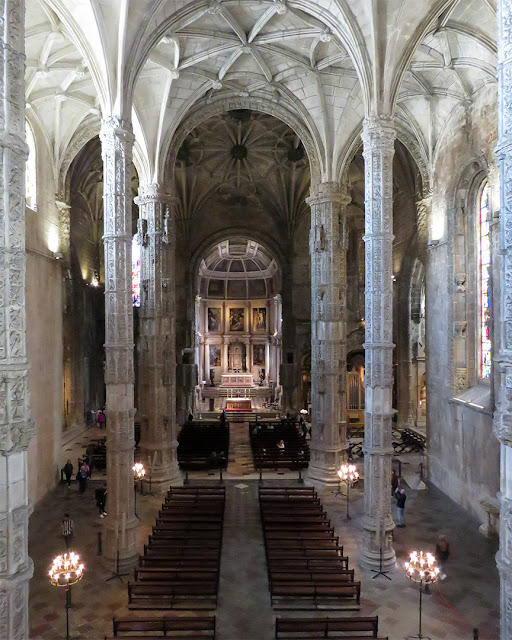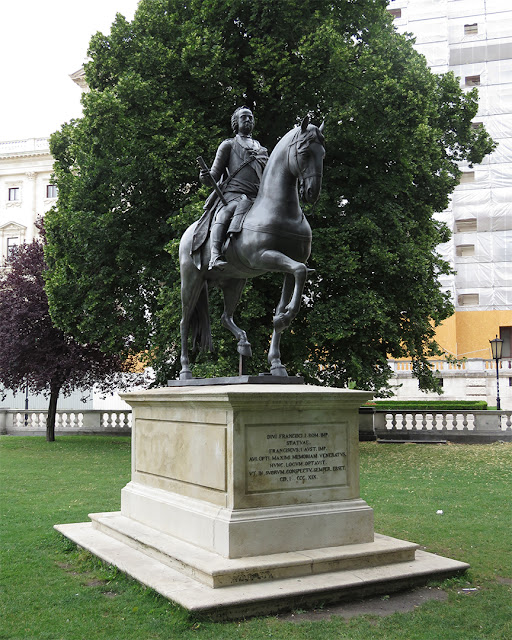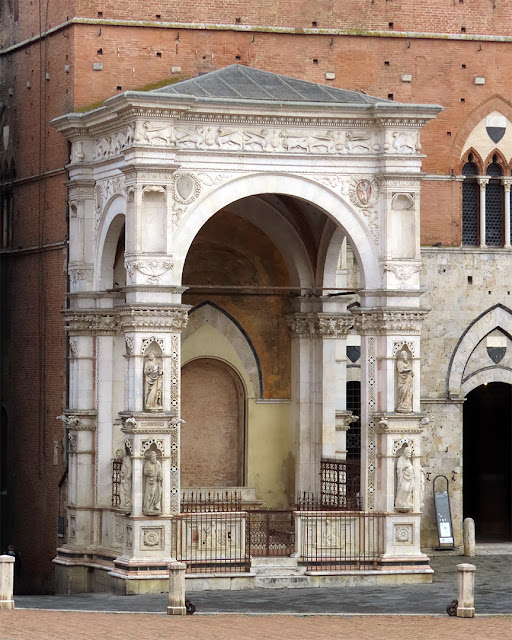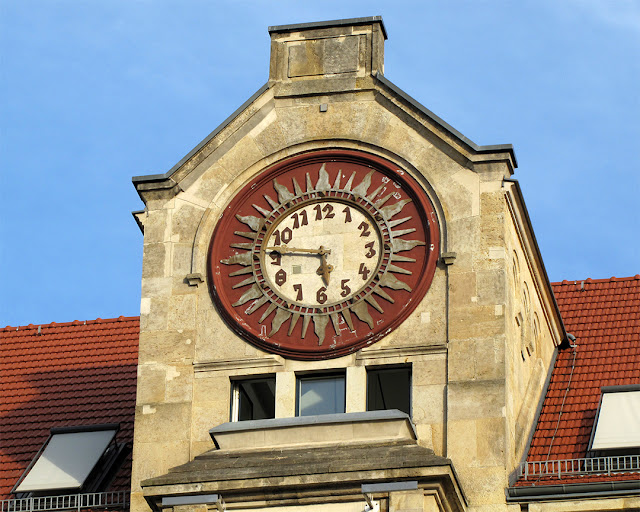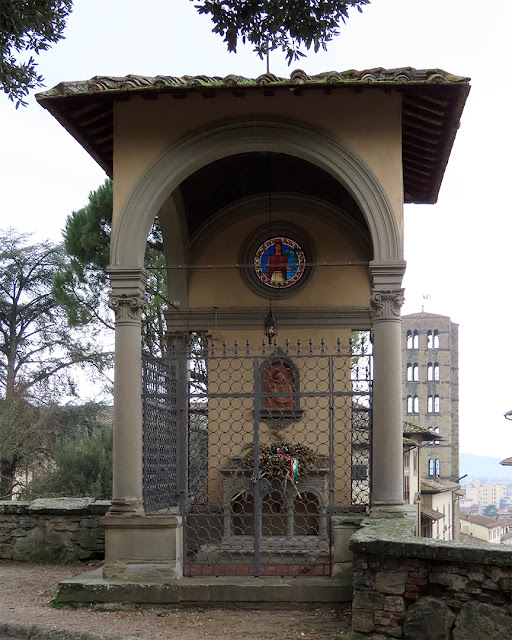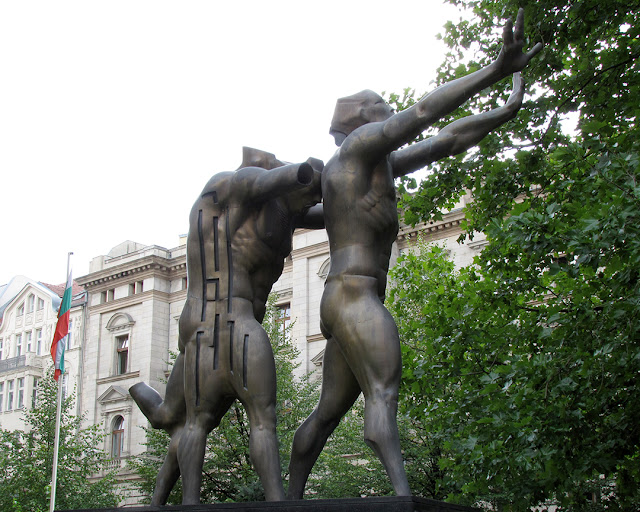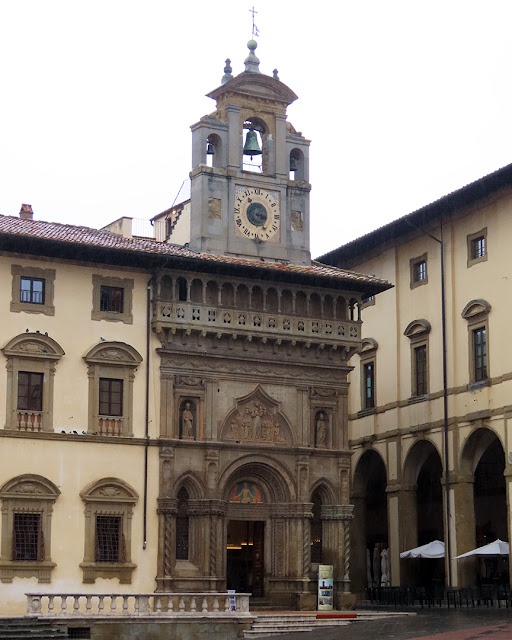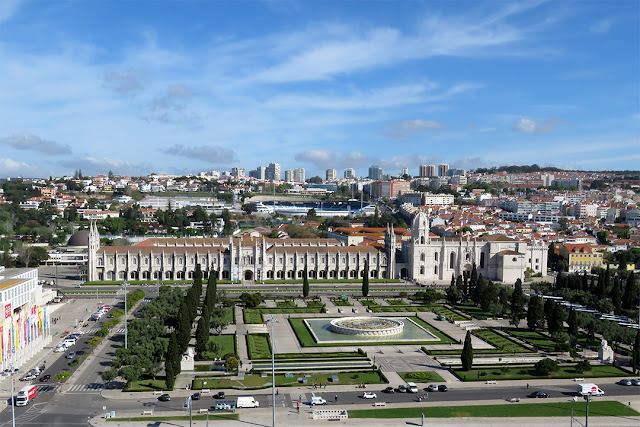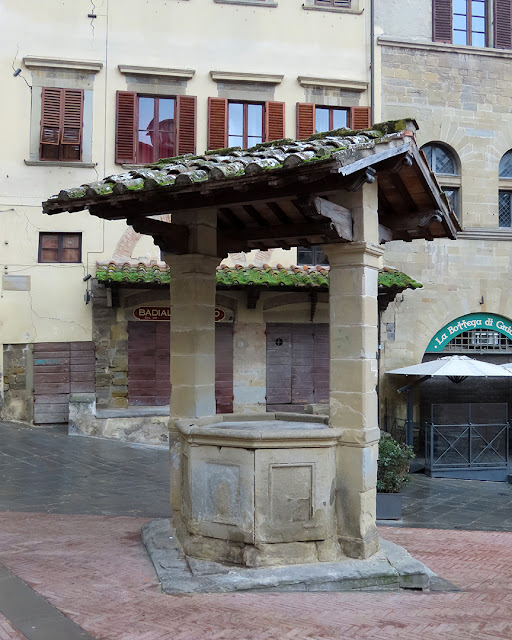Wednesday, May 31, 2023
Logge del Grano
Logge del Grano (Grain Lodges) Market
Piazzetta Logge del Grano
Arezzo, February 2022
“The Badia delle Sante Flora e Lucilla or Abbey of Saints Flora and Lucilla is a Medieval abbey in Arezzo, Tuscany, Italy. Construction of the church began in 1278; and by 1315, the adjacent monastery was built. The cloister (1489) was designed by Giuliano da Maiano. The church was rebuilt starting in 1565 under the designs of Giorgio Vasari. The work was not completed till 1650, when the bell-tower and presbytery were completed. The presbytery has altar (1563) designed by Vasari for his family and once in his parish church of Santa Maria, and moved here in 1865. The church also houses a painted Crucifix (1319) by Segna di Bonaventura and frescoes of the life of St Lawrence (1476) by Bartolomeo della Gatta. The cupola was painted on canvas (1702) by the Baroque painter Andrea Pozzo.” (Badia delle Sante Flora e Lucilla, Wikipedia)
Tuesday, May 30, 2023
Santa Maria de Belém
Church of Santa Maria de Belém
Mosteiro dos Jerónimos (Jerónimos Monastery)
Praça do Império, Belém
Lisbon, April 2019
“Diogo Boitac laid the foundations for this three-aisled church with five bays under a single vault, a clearly marked but only slightly projecting transept and a raised choir. The hall church layout is composed of aisles and nave that are of equal height. Boitac built the walls of the church as far as the cornices and then started with the construction of the adjoining monastery. Juan de Castillo, a Spanish architect and sculptor, continued the construction in 1517. He completed the retaining walls and the unique single-span ribbed vault, a combination of stellar vaulting and tracery vaults spanning the 19-metre (62-ft) wide church.[11] Each set of ribs in the vaulting is secured by bosses. The bold design (1522) of the transversal vault of the transept lacks any piers or columns, while Boitac had originally planned three bays in the transept. The transept's unsupported vault gives the visitor the impression that it floats in the air. Castilho also decorated the six 25-metre-high, slender, articulated, octagonal columns with refined grotesque or floral elements typical of the Renaissance style. The construction of this late-Gothic hall is aesthetically and architecturally a masterwork: it augments the spatial effect of this vast building. The northern column closest to the transept there is a medallion that may have been intentionally included as a portrait of Boitac or Juan de Castilho.” (Jerónimos Monastery, Wikipedia)
Monday, May 29, 2023
Sunday, May 28, 2023
Saturday, May 27, 2023
Badia delle Sante Flora e Lucilla
Badia delle Sante Flora e Lucilla (Abbey of Saints Flora and Lucilla)
Piazza della Badia
Arezzo, February 2022
“The Badia delle Sante Flora e Lucilla or Abbey of Saints Flora and Lucilla is a Medieval abbey in Arezzo, Tuscany, Italy. Construction of the church began in 1278; and by 1315, the adjacent monastery was built. The cloister (1489) was designed by Giuliano da Maiano. The church was rebuilt starting in 1565 under the designs of Giorgio Vasari. The work was not completed till 1650, when the bell-tower and presbytery were completed. The presbytery has altar (1563) designed by Vasari for his family and once in his parish church of Santa Maria, and moved here in 1865. The church also houses a painted Crucifix (1319) by Segna di Bonaventura and frescoes of the life of St Lawrence (1476) by Bartolomeo della Gatta. The cupola was painted on canvas (1702) by the Baroque painter Andrea Pozzo.” (Badia delle Sante Flora e Lucilla, Wikipedia)
Friday, May 26, 2023
Kaiser Franz I
Kaiser Franz I. Stephan von Lothringen
(Francis I, Holy Roman Emperor) by Balthasar Ferdinand Moll, 1780
Burggarten
Josefsplatz
Vienna, June 2018
“Francis I (Francis Stephen; French: François Étienne; German: Franz Stefan; Italian: Francesco Steffano; 8 December 1708 – 18 August 1765) was Holy Roman Emperor, Archduke of Austria, Duke of Lorraine and Bar, and Grand Duke of Tuscany. He became the ruler of the Holy Roman Empire, Austria, and Tuscany through his marriage to Maria Theresa, daughter of Emperor Charles VI. Francis was the last non-Habsburg monarch of both the Empire and Austria, which were effectively governed by Maria Theresa. The couple were the founders of the Habsburg-Lorraine dynasty, and their marriage produced sixteen children.” (Francis I, Holy Roman Emperor, Wikipedia)
Thursday, May 25, 2023
Iron ring
Iron ring, Palazzo Piccolomini
Banchi di Sotto
Siena, February 2022
“The Palazzo Piccolomini, also known as the Palazzo Todeschini Piccolomini is a Renaissance-style palace in the city of Siena, region of Tuscany, Italy. It is located on the Banchi di Sotto, at the corner with Via Rinaldini; uphill and west of the church of San Martino, the Loggia del Papa, and the Palazzo delle Papesse, which also built by a Piccolomini family member.” (Palazzo Piccolomini, Wikipedia)
Wednesday, May 24, 2023
Alte Feuerwache
Alte Feuerwache (Old Fire Station)
Bernburger Straße
Berlin, September 2011
“‘Alte Feuerwache’ (Old Fire Station) at Bernburger Strasse 35 in Berlin-Kreuzberg. The place is as a meeting place for 10-14 year old boys and girls, run by ‘Alte Feuerwache e.V.’ as part of their social youth work activites.” (Alte Feuerwache, Wikipedia)
Tuesday, May 23, 2023
Vittorio Fossombroni
Vittorio Fossombroni by Pasquale Romanelli, 1864
Piazza San Francesco
Arezzo, February 2022
“Marble statue of Fossombroni with in his right hand a scroll with the hydraulic engineering treaties about the reclamation of the swamps and having his hand on the head of a lion, which in turn has its right leg over a sphere: the allegory of power.” (Vittorio Fossombroni, René & Peter van der Krogt)
Monday, May 22, 2023
Two-storey cloisters
Two-storey cloisters
Mosteiro dos Jerónimos (Jerónimos Monastery)
Praça do Império, Belém
Lisbon, April 2019
“Work on the vast square cloister (55 × 55 m) of the monastery was begun by Boitac. He built the groin vaults with wide arches and windows with tracery resting on delicate mullions. Juan de Castilho finished the construction by giving the lower storey a classical overlay and building a more recessed upper storey. The construction of such a cloister was a novelty at the time. Castilho changed the original round columns of Boitac into rectangular ones, and embellished it with Plateresque-style ornamentation. Each wing consists of six bays with tracery vaults. The four inner bays rest on massive buttresses, forming broad arcades. The corner bays are linked by a diagonal arched construction and show the richly decorated corner pillars. The cloister had a religious function as well as a representative function by its decorative ornamentation and the dynastic symbolic motives, such as the armillarium, coat-of-arms, and the cross from the Order of Christ, showing the growing world power of Portugal. The inside walls of the cloister have a wealth of Manueline motives with nautical elements, in addition to European, Moorish and Eastern motifs. The round arches and the horizontal structure are clearly in line with the Renaissance architectural style, while at the same time there is also a relationship with Spanish architecture. The decorations on the outer walls of the inner courtyard were made in Plateresco style by Castilho: the arcades include traceried arches that give the construction a filigree aspect.” (Jerónimos Monastery, Wikipedia)
Sunday, May 21, 2023
Piazza del Campo
A view of the square
Piazza del Campo
Siena, February 2022
“Piazza del Campo is the main public space of the historic center of Siena, Tuscany, Italy and is regarded as one of Europe's greatest medieval squares. It is renowned worldwide for its beauty and architectural integrity. The Palazzo Pubblico and its Torre del Mangia, as well as various palazzi signorili surround the shell-shaped piazza. At the northwest edge is the Fonte Gaia. The twice-a-year horse-race, Palio di Siena, is held around the edges of the piazza. The piazza is also the finish of the annual road cycling race Strade Bianche.” (Piazza del Campo, Wikipedia)
Saturday, May 20, 2023
Neues Anhalter Tor
Neues Anhalter Tor (New Anhalter Gate)
Entrance portal of the Anhalter Bahnhof
Askanischer Platz
Berlin, September 2011
“Due to its location, the Soviets switched all remaining trains to the Ostbahnhof in the Russian sector on 17 May 1952. With no services, the Anhalter Bahnhof was closed. Although detailed plans and an architect's model were drawn up to build a vast modern terminus on the site, nothing happened. After lying derelict for more than eight years, with some tracks and signals still in situ, demolition was begun on 25 August 1960 and completed by 27 August despite considerable public outcry. Part of the centre portion of the façade was allowed to remain standing.” (Berlin Anhalter Bahnhof, Wikipedia)
Friday, May 19, 2023
Basilica of San Francesco
Basilica of San Francesco
Piazza San Francesco
Arezzo, February 2022
“The Basilica of San Francesco is a late Medieval church in Arezzo, Tuscany, Italy, dedicated to St Francis of Assisi. It is especially renowned for housing in the chancel the fresco cycle Legends of the True Cross by Piero della Francesca. San Francesco is the second church built by the Franciscans in Arezzo, an earlier church being located outside the city walls and destroyed during the Occupation. The building work on San Francesco was begun around 1290. The decoration of its façade was never realised. The interior presents as a large church of simple unadorned design with a wide single nave, flanked on the left side by some chapels and, on the right side, by some niches. The tall groin-vaulted chancel is of square plan. Beneath the church is a smaller Chiesa inferiore or ‘Lower Church’ as at Assisi, with a nave and two aisles, now used as exhibition hall.” (Basilica of San Francesco, Wikipedia)
Thursday, May 18, 2023
Wednesday, May 17, 2023
Cappella di Piazza
Cappella di Piazza
Piazza del Campo
Siena, February 2022
“The Chapel of Piazza del Campo, located inside the square of the same name, is a marble construction erected at the base of the Tower of Mangia. The prevailing thesis is that the work was made to thank the gods for the end of the plague that had heavily affected the Tuscan city in the twelfth - thirteenth centuries. The construction works, according to documents of the time, began in 1325 on a project by the architect Domenico D'Agostino and were completed by Giovanni De Cecco around 1376. The Gothic features of the structure are attributable to the latter. The decorations and ornamentation were entrusted first to the sculptor Antonio Federighi and then to Giovanni Antonio Bazzi, known as ‘Sodoma’, who concentrated mainly on the fresco above the altar, unfortunately now almost completely damaged.” (Chapel of Piazza del Campo, Nice Places)
Tuesday, May 16, 2023
Monday, May 15, 2023
La Hermana y la Herida
“La Hermana y la Herida” (The Sister and the Wounded) by Abel Vallmitjana, 1975
Giardino del Praticino (Praticino Gardens)
Via dell'Orto
Arezzo, February 2022
“Sculpture representing two feminine figures embraced by the anguished and suffering expression. When the Chilean poet Pablo Neruda visited the sculptor in his studio in Tregozzano near Arezzo he saw the plaster model and called it ‘La Hermana y La Herida’, or ‘The Sister and the Wounded’. When Vallmitjana died, the sculpture was still unfinished. His widow had it finished and cast and donated it to the city of Arezzo.” (The Sister and the Wounded, René & Peter van der Krogt)
Sunday, May 14, 2023
Vasco da Gama
Neomanueline tomb of Vasco da Gama
Mosteiro dos Jerónimos (Jerónimos Monastery)
Praça do Império, Belém
Lisbon, April 2019
“To celebrate the 1898 fourth centenary of the arrival of Vasco da Gama in India, it was decided to restore the tomb of the explorer in 1894. The tombs of Vasco da Gama and Luís de Camões, carved by the sculptor Costa Mota, were placed in the southern lateral chapel. A year later the monastery received the remains of the poet João de Deus, later joined by the tombs of Almeida Garret (1902), Sidónio Pais (1918), Guerra Junqueiro (1923) and Teófilo Braga (1924).” (Jerónimos Monastery, Wikipedia)
Saturday, May 13, 2023
Fonte Gaia
Fonte Gaia (Joyous Fountain)
Piazza del Campo
Siena, February 2022
“The Fonte Gaia (Joyous Fountain) was built in 1419 as an endpoint of the system of conduits bringing water to the city's centre, replacing an earlier fountain completed about 1342 when the water conduits were completed. Under the direction of the Committee of Nine, many miles of tunnels were constructed to bring water in aqueducts to fountains and thence to drain to the surrounding fields. The present fountain, a center of attraction for the many tourists, is in the shape of a rectangular basin that is adorned on three sides with many bas-reliefs with the Madonna surrounded by the Classical and the Christian Virtues, emblematic of Good Government under the patronage of the Madonna. The white marble Fonte Gaia was originally designed and built by Jacopo della Quercia, whose bas-reliefs from the basin's sides are conserved in the Ospedale di St. Maria della Scala in Piazza Duomo. The former sculptures were replaced in 1866 by free copies by Tito Sarrocchi, who omitted Jacopo della Quercia's two nude statues of Rhea Silvia and Acca Larentia, which the nineteenth-century city fathers found too pagan or too nude. When they were set up in 1419, Jacopo della Quercia's nude figures were the first two female nudes, who were neither Eve nor a repentant saint, to stand in a public place since Antiquity.” (Piazza del Campo, Wikipedia)
Friday, May 12, 2023
Thursday, May 11, 2023
Wednesday, May 10, 2023
Omofuma Denkmal
Omofuma Denkmal (Omofuma memorial) by Ulrike Truger, 2003
Mariahilfer Straße
Vienna, June 2018
“Marcus Omofuma (10 May 1973 – 1 May 1999) was a Nigerian asylum seeker in Austria who died due to police brutality while being deported. His death became a symbol for anti-racist movements in Austria. Omofuma was part of the Yoruba fraternity Ogboni and was escaping Nigeria from death threats within the fraternity. In 1994, he arrived in Germany and failed to gain asylum. In November 1998, he fled to Austria and again sought for asylum due to his persecution by the Ogboni fraternity. The Austrian authorities declined his asylum in two instances and detained him from December 1998 on. On 1 May 1999, 25-year-old Omofuma was being deported from Austria. Three police officers put him in a plane operated by Balkan Airlines to Sofia. Because he was resisting, they fettered and gagged him and fixed him on his plane seat. The tape that was used to fetter him was not checked during the whole flight and it made it impossible for him to breathe. He died painfully during the ca. 1 hour flight. His death was realized when landing in Sofia.” (Marcus Omofuma, Wikipedia)
Tuesday, May 9, 2023
Palazzo Pubblico
Palazzo Pubblico (Town Hall)
Piazza del Campo
Siena, February 2022
“The Palazzo Pubblico (town hall) is a palace in Siena, Tuscany, central Italy. Construction began in 1297 to serve as the seat of the Republic of Siena's government, which consisted of the Podestà and Council of Nine, the elected officials who performed executive functions (and judicial ones in secular matters).” (Palazzo Pubblico, Wikipedia)
Monday, May 8, 2023
To Break the Wall
“To Break the Wall” by Georgi Tschapkanow, 2006
Embassy of Bulgaria
Leipziger Straße / Mauerstraße
Berlin, September 2011
Sunday, May 7, 2023
Palazzo della Fraternita dei Laici
Palazzo della Fraternita dei Laici (Palace of the Lay Fraternity) by Bernardo Rossellino, 1550
Piazza Grande
Arezzo, February 2022
Saturday, May 6, 2023
Mosteiro dos Jerónimos
Mosteiro dos Jerónimos (Jerónimos Monastery)
View from the top of Padrão dos Descobrimentos
Praça do Império, Belém
Lisbon, April 2019
“The Jerónimos Monastery or Hieronymites Monastery (Portuguese: Mosteiro dos Jerónimos) is a former monastery of the Order of Saint Jerome near the Tagus river in the parish of Belém, in the Lisbon Municipality, Portugal. It became the necropolis of the Portuguese royal dynasty of Aviz in the 16th century but was secularized on 28 December 1833 by state decree and its ownership transferred to the charitable institution, Real Casa Pia de Lisboa. The Jerónimos Monastery is one of the most prominent examples of the late Portuguese Gothic Manueline style of architecture in Lisbon. It was erected in the early 1500s near the launch point of Vasco da Gama's first journey, and its construction funded by a tax on the profits of the yearly Portuguese India Armadas. In 1880, da Gama's remains and those of the poet Luís de Camões (who celebrated da Gama's first voyage in his 1572 epic poem, The Lusiad), were moved to new carved tombs in the nave of the monastery's church, only a few meters away from the tombs of the kings Manuel I and John III, whom da Gama had served. In 1983, the Jerónimos Monastery was classified as a UNESCO World Heritage Site, along with the nearby Tower of Belém.” (Jerónimos Monastery, Wikipedia)
Friday, May 5, 2023
Gavinone
The “gavinone” (the central water drain)
Piazza del Campo
Siena, February 2022
“The open site was a marketplace established before the thirteenth century on a sloping site near the meeting point of the three hillside communities that coalesced to form Siena: the Castellare, the San Martino and the Camollia. Siena may have had earlier Etruscan settlements, but it was not a considerable Roman settlement, and the campo does not lie on the site of a Roman forum, as is sometimes suggested. It was paved in 1349 in fishbone-patterned red brick with 8 lines of travertine, which divide the piazza into 9 sections, radiating from the mouth of the gavinone (the central water drain) in front of the Palazzo Pubblico. The number of divisions is held to be symbolic of the rule of The Nine (Noveschi) who laid out the campo and governed Siena at the height of its mediaeval splendour between 1292-1355. The Campo was and remains the focal point of public life in the City. From the piazza, eleven narrow shaded streets radiate into the city.” (Piazza del Campo, Wikipedia)
Thursday, May 4, 2023
Arkaden
Potsdamer Platz Arkaden
Eichhornstraße
Berlin, September 2011
“From 2022, the Potsdamer Platz Arkaden will offer a completely new shopping experience after extensive renovation work. The plan is to have 90 shops in six theme worlds ranging from fashion and lifestyle to sports and technology. There will also be a name change: The Playce.” (The Playce, Berlin.de)
Wednesday, May 3, 2023
The old well
The old well
Piazza Grande
Arezzo, February 2022
“Twice a year the Saracino Joust fills this place with magic. The banners of the flag-wavers color the sky, drum rolls and claps of light resound in the air. From the well of Piazza Grande the knights of the four districts of Arezzo leave in career launches in remnant to challenge the Buratto King of the Indies.” (Piazza Grande and the Vasari Loggia, Discover Arezzo)
Tuesday, May 2, 2023
Haus des Meeres
Haus des Meeres (House of the Sea)
Esterházypark
Fritz-Grünbaum-Platz
Vienna, June 2018
“The Haus des Meeres (HdM, House of the Sea) is a public aquarium in Vienna, Austria. It is located in Esterhazy Park in downtown Mariahilf district, one block south of the busy Mariahilfer Straße. The Haus des Meeres houses over ten thousand aquatic beings on an area of around 4,000 square meters (43,000 sq ft) inside a tall concrete flak tower built during World War II. In 2012 the Haus des Meeres attracted a record high of 650,000 visitors. The Haus des Meeres is managed by Aqua Terra Zoo, a private non-profit organization which, according to its web site, receives only marginal financial support from municipal authorities. However, the maintenance costs for the former flak tower are paid by the taxpayer.” (Haus des Meeres, Wikipedia)
Monday, May 1, 2023
Loggia della Mercanzia
Loggia della Mercanzia
Croce del Travaglio
Via di Città
Siena, February 2022
“The elegant Loggia della Mercanzia, known also as Loggia di San Paolo or Loggia Dei Nobili, is typical of Senese architecture in its transition from Medieval to Renaissance – a development that was slower in this city than in the rest of Italy and that is marked by the persistence of gothic details. The Loggia della Mercanzia is directly behind Piazza del Campo, at a point known as the Croce del Travaglio junction of the three main streets around which Siena is developed: Banchi di Sopra, Banchi di Sotto (a branch of the old Via Francigena that ran through the city) and Via di Città. Designed by Sano di Matteo and Pietro del Minella between 1417 and 1428, the Gothic-Renaissance Loggia della Mercanzia is composed of a spacious loggia with three arches supported above richly adorned columns and capitols. The original construction was raised in the 17th century with the addition of tabernacles placed against the supporting columns, containing 15th century statues by Vecchietta, who sculpted a St Paul in 1458 and a St Peter in 1460. Antonio Federighi is responsible for the St Savino, the St Ansano and the St Vittore, all sculpted between 1456 and 1463. The marble slabs within the loggia are decorated with reliefs: Illustrious Romans by Federighi (1464) and Cardinal Virtues by Urbano da Cortona to the left.” (Loggia della Mercanzia, Siena Online)
Subscribe to:
Posts (Atom)


